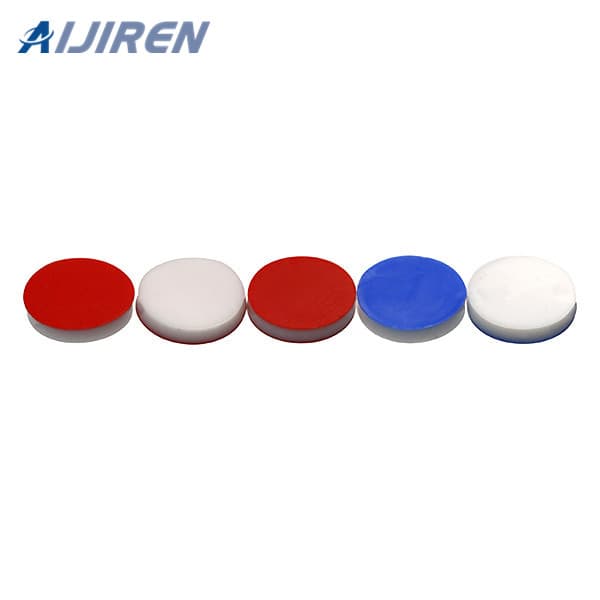Dec. 23rd, 2024
High Performance Liquid Chromatography (HPLC) is an important analytical technique used in various fields such as pharmaceuticals, environmental analysis, and food safety. A key component of an HPLC system is the vial septum, which serves as a closure for the vial. A vial septum is a closure that seals the vial opening, allowing needle penetration while maintaining a secure seal to prevent contamination and evaporation. They must be compatible with the solvent being analyzed and should withstand the HPLC process conditions.
Importance of Selecting the Right Septa
Choosing the right septum is critical to:
Preventing contamination: Incompatible substances can seep into the sample or react with the solvent.
Ensuring a proper seal: A good seal prevents sample loss and maintains integrity.
Facilitating multiple injections: Some septa are designed to be reusable without degradation.
Want To Know Full Knowledge About PTFE/Silicone Septa, Please Check This Article: Everything You Need to Know:137 Pre-slit PTFE/Silicone Septa FAQs
HPLC Vial Septa Material Types
Different materials have different properties that affect their performance in HPLC applications. The following are the materials commonly used in HPLC vial septa:
1. PTFE (Polytetrafluoroethylene)
Features: PTFE has excellent chemical resistance, is highly inert and can withstand aggressive solvents.
Uses: Not suitable for multiple injections or long-term storage due to its inability to reseal after being punctured, making it ideal for single-use applications.
High Temperature Resistance: Withstands temperatures up to 260°C.
Cost: Generally economical compared to other materials.
2. PTFE/Silicone Septa
Features: Combines the chemical resistance of PTFE with the resealability of silicone.
Uses: Recommended for multiple injections and sample storage due to its excellent resealability.
Temperature Range: Effective from -40°C to 200°C.
Autoclavable: Suitable for sterilization processes.

3. Pre-cut PTFE/Silicone Septa
Features: Designed to minimize coring when using blunt-tipped needles; reduces vacuum formation in vials.
Uses: Suitable for applications where frequent needle contact is required without compromising septum integrity.
Temperature Range: Similar to PTFE/Silicone, -40°C to 200°C.
.jpg)
4. Butyl Rubber
Properties: Good sealing properties, but limited chemical resistance compared to PTFE.
Uses: Suitable for aqueous solutions and less aggressive solvents; can be used in applications requiring an airtight seal.
High Temperature Resistance: Good at lower temperatures, but may degrade at high temperatures or with aggressive solvents.
5. Viton
Properties: Highly resistant to aggressive chemicals and retains some ability to reseal after puncture.
Uses: Considered a last resort due to high cost; suitable for applications where other materials have failed.
High Temperature Resistance: Effective at high temperatures, but requires careful handling due to its rigidity.
Factors to Consider When Selecting HPLC Vial Septa
1. Chemical compatibility
The first thing to consider is the chemical compatibility of the septum material with the solvents you plan to use. Different materials have different tolerances to chemicals:
PTFE (polytetrafluoroethylene): PTFE is known for its excellent chemical resistance and is suitable for a wide range of solvents, including corrosive chemicals. It is often used in combination with other materials.
Silicone: Silicone septa are flexible and can be resealed after needle penetration, making them suitable for repeated injections. However, they may not be compatible with all solvents.
Butyl rubber: This material has good sealing properties, but has limited chemical resistance compared to PTFE.
PTFE/silicone composite: Combines the advantages of both materials, with good chemical compatibility and resealability.
2. Solvent Type
The type of solvent used will also influence septum selection:
Aqueous solutions: For water-based solvents, silicone or PTFE/silicone septa are often recommended due to their excellent compatibility.
Organic solvents: For organic solvents such as methanol or acetonitrile, PTFE or PTFE/silicone composites are preferred due to their excellent chemical resistance.
Corrosive chemicals: For highly corrosive solvents such as strong acids or bases, PTFE is often the best choice.
3. Sealing performance
The ability of a septum to reseal after a needle puncture is critical to maintaining sample integrity:
Slit vs. non-slit design: Some septa have slits to facilitate needle insertion, but this may affect the seal over time. Non-slit designs provide a tighter seal but may require more force when injecting.
Resealability: Look for septa that can effectively reseal after multiple needle punctures to prevent contamination and evaporation.
Want to know whether to choose septa in Pre-slit or Not? please check this article: How to Choose a Septa Pre-slit or Not?
4. Extractables and Leachables
When working with sensitive samples, it is critical to consider extractables and leachables in the septum material:
Low Extractables: Select septa with low extractables to minimize the risk of contamination. PTFE has low extractables compared to rubber-based materials.
Testing Standards: Some manufacturers provide data on extractables; review these specifications when selecting a septum.
5. High Temperature Resistance
Consider the temperature range in which your HPLC system will operate:
High Temperature: If your application involves high temperatures, make sure the septum material can withstand these conditions without degradation.
Cryogenic Applications: For cryogenic applications, select a material that maintains integrity at low temperatures.
6. Physical Properties
The physical characteristics of the septum can also affect performance:
Thickness: Thicker septa may provide a better seal but may require more force during needle penetration.
Hardness: Softer materials may provide better resealability but may be more susceptible to damage during repeated use.
Selecting the right HPLC vial septum requires careful consideration of solvent compatibility, sealing capabilities, high temperature resistance, and specific analytical needs. By understanding the properties of different materials and their applications, researchers can significantly improve the accuracy and reliability of HPLC analyses. The right choice not only improves performance, but also minimizes the risks associated with sample degradation and contamination.


 English
English
 Chinese
Chinese

.jpg)
